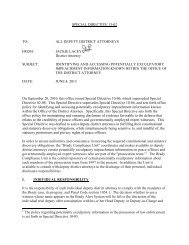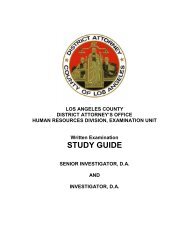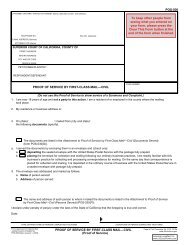[PROPOSED] SPECIAL DIRECTIVE 13-01
[PROPOSED] SPECIAL DIRECTIVE 13-01
[PROPOSED] SPECIAL DIRECTIVE 13-01
Create successful ePaper yourself
Turn your PDF publications into a flip-book with our unique Google optimized e-Paper software.
<strong>SPECIAL</strong> <strong>DIRECTIVE</strong> <strong>13</strong>-<strong>01</strong><br />
TO:<br />
ALL DEPUTY DISTRICT ATTORNEYS<br />
FROM: JACKIE LACEY<br />
District Attorney<br />
SUBJECT:<br />
GENERAL POLICY REGARDING DISCLOSURE OF<br />
EXCULPATORY INFORMATION<br />
DATE: JUNE 4, 20<strong>13</strong><br />
Subject to any future changes in the law, this Special Directive sets forth the office policy<br />
regarding disclosure of exculpatory information pursuant to Brady v. Maryland (1963) 373<br />
U.S.83, its progeny, and Penal Code Section 1054.1(e). To the extent that this Special Directive<br />
conflicts with previous policies, this Special Directive controls.<br />
It is imperative that deputy district attorneys understand and comply with their duty to disclose<br />
favorable evidence to the defense. In the event a deputy district attorney is unsure whether<br />
disclosure is warranted, the deputy district attorney shall consult with their Head Deputy or<br />
Deputy-in-Charge. If additional guidance is needed regarding whether information falls within a<br />
deputy district attorney’s constitutional or statutory disclosure obligations, the Brady<br />
Compliance Unit should be consulted.<br />
A reviewing court looking at a possible Brady violation is “dealing with an inevitably imprecise<br />
standard.” [United States v. Agurs (1976) 427 U.S. 97, 108.] Because the “significance of an<br />
item of evidence can seldom be predicated accurately until the entire record is complete, the<br />
prudent prosecutor will resolve doubtful questions in favor of disclosure.” (Id.) It is the<br />
prosecutor’s duty, since he or she is the only one aware of the possible impact of undisclosed<br />
evidence, to make the decision to disclose at the point when a “reasonable probability” is<br />
reached. (Kyles v. Whitley (1995) 514 U.S. 419, 437.) “This means, naturally, that a prosecutor<br />
anxious about tacking too close to the wind will disclose a favorable piece of evidence.” (Id. At<br />
p. 439.) Making such a disclosure justifies the trust placed in prosecutors as individuals seeking<br />
justice. (Ibid.)<br />
Deputy district attorneys should remain mindful that complying with our duties under Brady<br />
does not require the disclosure of preliminary, challenged, or speculative information (United<br />
States v. Agurs, supra, 427 U.S. at 108.). However, it is not the role of the prosecutor to decide<br />
that facially exculpatory evidence need not be turned over because the prosecutor thinks the<br />
information is false. It is “the criminal trial, as distinct from the prosecutor’s private<br />
deliberations,” that is the “chosen forum for ascertaining the truth about criminal accusations.”
(United States v. Alvarez (9 th Cir. 1996) 86 F.3d 9<strong>01</strong>, 905; Kyles v. Whitley, supra, 514 U.S. 419<br />
at p. 440.)<br />
Deputy district attorneys have individual disclosure obligations under both Penal Code Section<br />
1054.1 and Brady. These differing disclosure obligations are discussed in turn.<br />
I. WHAT IS REQUIRED UNDER PENAL CODE SECTION 1054.1(e)<br />
Penal Code sections 1054 et seq. govern prosecution and defense discovery in criminal cases.<br />
Penal Code Section 1054.1(e) provides that deputies “shall disclose” to a defendant or his or her<br />
attorney “[a]ny exculpatory evidence” in the deputy district attorney’s possession or known to be<br />
in the possession of the investigating agencies. This statute “requires the prosecution to disclose<br />
‘[a]ny exculpatory evidence,’ not just material exculpatory evidence.” Barnett v. Superior<br />
Court, 50 Cal. 4th 890, 9<strong>01</strong> (2<strong>01</strong>0); see also People v. Bowles, 198 Cal. App. 4th 318, 326<br />
(2<strong>01</strong>1).<br />
Absent good cause, these disclosures shall be made at least 30 days before trial. Because<br />
discovery is a continuing obligation, if new information becomes known to, or comes into the<br />
possession of, the deputy district attorney that was not turned over to the other party initially,<br />
disclosure of the new information shall be made as soon as possible. If the new information<br />
becomes known to, or comes into the possession of, the deputy district attorney within 30 days of<br />
trial, disclosure shall be made immediately, unless good cause is shown why a disclosure should<br />
be denied, restricted, or deferred. (Penal Code section 1054.7.)<br />
II.<br />
WHAT IS REQUIRED UNDER BRADY<br />
Prosecutors are required to disclose to the defense evidence favorable to a defendant that is either<br />
exculpatory or impeaching and is material to either guilt or punishment. Evidence is "favorable"<br />
to the defendant if it either helps the defendant or hurts the prosecution. (In re Sassounian (1995)<br />
9 Ca1.4th 535, 543-544.) In Strickler v. Greene (1999) 527 U.S. 263, 280, the United States<br />
Supreme Court stated:<br />
In Brady this Court held "that the suppression by the prosecution of evidence<br />
favorable to an accused upon request violates due process where the evidence is<br />
material either to guilt or to punishment, irrespective of the good faith or bad faith<br />
of the prosecution." Brady v. Maryland, supra, 373 U.S., at 87. We have since<br />
held that the duty to disclose such evidence is applicable even though there has<br />
been no request by the accused, (United States v. Agurs , supra, 427 U.S. at p.<br />
107.), and that the duty encompasses impeachment evidence as well as<br />
exculpatory evidence, [United States v. Bagley (1985) 473 U.S. 667,676]. Such<br />
evidence is material "if there is a reasonable probability that had the evidence<br />
been disclosed to the defense, the result of the proceeding would have been<br />
different." Id. at 682; see also [Kyles v. Whitley, supra, 514 U.S. at pp. 433-434].<br />
2
In order to ensure compliance with these rules, the United States Supreme Court on more than<br />
one occasion has urged the "careful prosecutor" to err on the side of disclosure. (Kyles v. Whitley,<br />
supra, 514 U.S. at p. 440; United States v. Agurs, supra, 427 U.S. at p. 110.)<br />
A. Material Evidence<br />
The definition of "material evidence" is generally provided in the context of an appeal from a<br />
conviction. Evidence is material if there is a reasonable probability that the result of the<br />
proceeding would have been different had the evidence been disclosed. A reasonable probability<br />
of a different outcome is shown where suppression undermines confidence in the outcome. Such<br />
evidence must have a specific, plausible connection to the case, and must demonstrate more than<br />
minor inaccuracies. (Kyles v. Whitley, supra, 514 U.S. at p. 434; United States v. Bagley, supra,<br />
473 U.S. at p.683; People v. Padilla (1995) 11 Cal. 4th 891, 929-932; People v. Clark (1992) 3<br />
Cal. 4th 41, <strong>13</strong>3-34.) However, as prosecutors we must determine what Brady evidence there<br />
may be before trial. In making this assessment, the deputy district attorney shall utilize the<br />
above Guidelines.<br />
B. Exculpatory Evidence<br />
Exculpatory evidence under Brady is evidence favorable to the defendant and material to the<br />
issue of guilt or punishment.<br />
C. Impeachment Evidence<br />
Evidence Code section 780 states, in part, that:<br />
Except as otherwise provided by statute, the court or jury may consider in<br />
determining the credibility of a witness any matter that has any tendency in reason<br />
to prove or disprove the truthfulness of his testimony at the hearing, including but<br />
not limited to, any of the following:<br />
…<br />
(e) His character for honesty or veracity or their opposites.<br />
(f) The existence or nonexistence of a bias, interest or other motive.<br />
…<br />
(h) A statement made by him that is inconsistent with any part of his testimony at<br />
the hearing.<br />
(Emphasis added.)<br />
CALJIC No. 2.20 (Spring ed. 2<strong>01</strong>0) adds conviction of a felony and past criminal conduct of a<br />
witness amounting to a misdemeanor as considerations for determining witness credibility.<br />
CALCRIM No. 316 (Spring ed. 2<strong>01</strong>0) adds conviction of a felony and criminal or other<br />
misconduct with or without a conviction as considerations. If impeachment evidence is based<br />
upon the prior commission of a crime, the crime must involve moral turpitude to be admissible.<br />
(People v. Castro (1985) 38 Cal.3d 3<strong>01</strong>, 314 [felonies]; People v. Wheeler (1992) 4 Cal.4th<br />
3
284,295-297 [misdemeanor conduct].) Additional examples of possible impeachment evidence<br />
of a material prosecution witness include:<br />
1. False reports by a prosecution witness (People v. Hayes (1992) 3 Cal.App.4th<br />
1238, 1244);<br />
2. Pending criminal charges against a prosecution witness (People v. Coyer<br />
(1983) 142 Cal.App.3d 839, 842);<br />
3. Parole or probation status of the witness (Davis v. Alaska (1974) 415 U.S.<br />
308, 319; People v. Price (1991) 1 Cal.4th 324, 486);<br />
4. Evidence contradicting a prosecution witness' statements or reports (People v.<br />
Boyd (1990) 222 Cal.App.3d 541, 568-569);<br />
5. Evidence undermining a prosecution witness' expertise (e.g., inaccurate<br />
statements) (People v. Garcia (1993) 17 Cal.App.4th 1169, 1179);<br />
6. A finding of misconduct by a Board of Rights or Civil Service Commission<br />
that reflects on the witness' truthfulness, bias or moral turpitude (cf. People v.<br />
Wheeler, supra, 4 Cal.4th at p. 293) (Note that the burden of proof in an<br />
administrative hearing is preponderance of the evidence.);<br />
7. Evidence that a witness has a reputation for untruthfulness (3 Witkin Cal.<br />
Evidence (4th ed. 2000) §§ 288-290);<br />
8. Evidence that a witness has a racial, religious or personal bias against the<br />
defendant individually or as a member of a group (In re Anthony P. (1985)<br />
167 Cal.App.3d 502, 507-510); or<br />
9. Promises, offers or inducements to the witness, including a grant of immunity<br />
(United States v. Bagley, supra, 473 U.S. at pp. 676-677; Giglio v. United<br />
States (1972) 405 U.S. 150, 153-155).<br />
A thorough review of all other types of available information must be made before a<br />
determination is reached that evidence concerning the credibility of a material prosecution<br />
witness is impeachment evidence.<br />
lp<br />
4


![[PROPOSED] SPECIAL DIRECTIVE 13-01](https://img.yumpu.com/38563244/1/500x640/proposed-special-directive-13-01.jpg)



